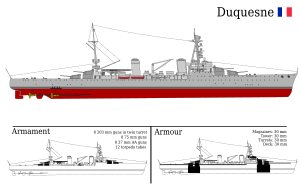Duquesne-class cruiser

Duquesne in her 1939 configuration
|
|
| Class overview | |
|---|---|
| Name: | Duquesne class |
| Operators: |
|
| Preceded by: | Duguay-Trouin class |
| Succeeded by: | Suffren class |
| Built: | 1924–1928 |
| In service: | 1928–1950 |
| In commission: | 1928–1950 |
| Completed: | 2 |
| Retired: | 2 |
| General characteristics | |
| Type: | Heavy cruiser |
| Displacement: |
|
| Length: | 191 m (626 ft 8 in) overall |
| Beam: | 19 m (62 ft 4 in) |
| Draught: | 6.32 m (20 ft 9 in) |
| Installed power: | 120,000 horsepower (89,000 kW) |
| Propulsion: | 4-shaft Rateau-Bretagne single-reduction geared turbines, 9 Guyot boilers |
| Speed: | 33.75 knots (62.51 km/h) |
| Range: | 4,500 nautical miles (8,300 km) at 15 knots (28 km/h) |
| Complement: | 605 |
| Armament: |
|
| Armour: |
|
| Aircraft carried: | 2 GL-812 (superseded by GL-832 then Loire-Nieuport 130, 1 catapult |
| Notes: | |
The Duquesne class was the first class of post Washington Treaty heavy cruisers built for the French Navy. They have been criticised by naval architects for having very little armour and being lightly built. However, they were considered to be good steamers and seaworthy vessels which could maintain 30 knots (56 km/h; 35 mph) indefinitely at half power.
Duquesne spent the opening months of World War II assigned to one of the South Atlantic hunting groups searching for the pocket battleship Admiral Graf Spee, while Tourville searched for German ships in the Mediterranean Sea. Both ships were assigned to Force X in the Mediterranean following the Italian declaration of war, and were "demilitarized" in Alexandria harbor from 1940 through mid-1943. Both were then refitted in the United States, landing their torpedo tubes, catapults and aircraft, and being given an augmented anti-aircraft armament of eight Bofors 40 mm guns and sixteen Oerlikon 20 mm cannon. They patrolled the mid-Atlantic for Axis blockade runners; but their anti-aircraft protection was still considered inadequate to provide gunfire support for the invasion of Normandy. Duquesne was part of the French Naval Task Force formed in December 1944 to bombard pockets of German resistance on the French Atlantic coast; and both ships participated in the French reoccupation of French Indochina in 1946.
Duquesne in original anti-surface layout
Tourville after refit: reinforced anti-air armament, removal of sea plane, torpedo launchers and aft mast
Tourville in 1929
...
Wikipedia
